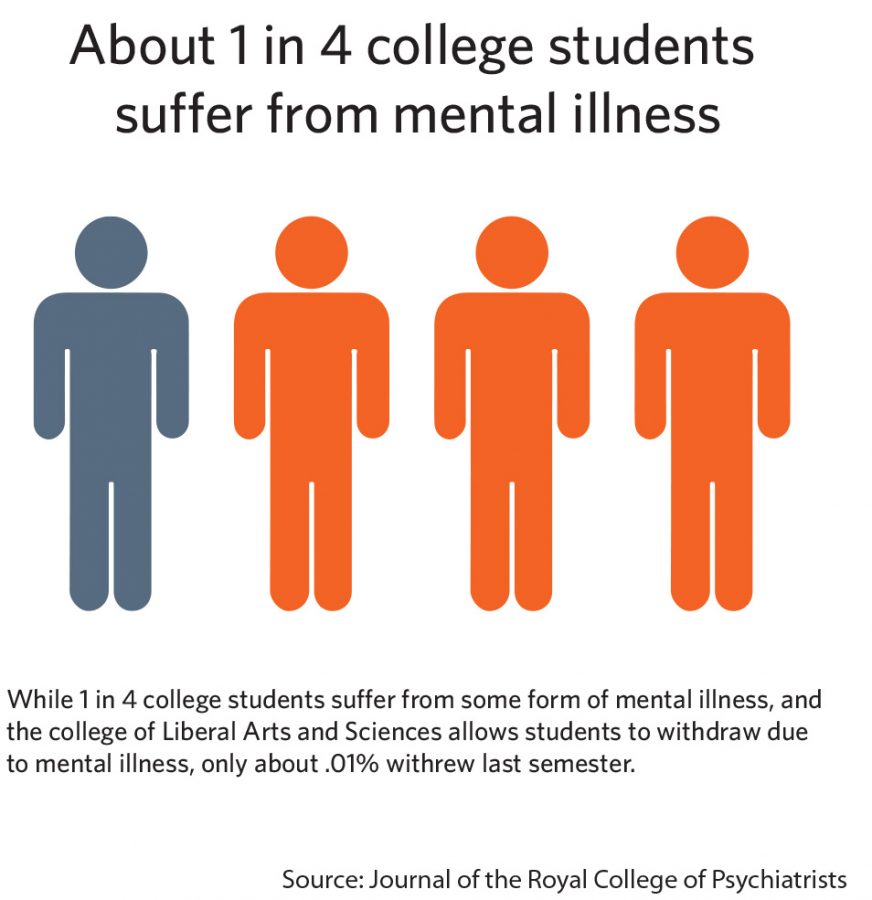Withdrawal process allows students time to treat mental health
March 6, 2017
One little-known option the University offers is to take a break from classes for a semester or a year to help students treat their mental illness.
About one in four college students suffer from some form of mental illness, according to the Journal of the Royal College of Psychiatrists, and around 44 percent of American college students report experiencing depression symptoms.
Still, few students actually withdraw, which is a process offered by the University in which a student can leave school for a semester or more, due to extenuating circumstances.
Erin Kim, junior in Engineering, knows first-hand about having depression and anxiety in college. Starting her freshman year, Kim began to develop depression but did not realize it at the time.
“But as the school year went by, I fell into a really deep depression and had really bad anxiety,” Kim said in an email. “I was doing poorly academically.”
Get The Daily Illini in your inbox!
Kim also faced difficulty doing daily tasks, like getting out of bed and attending classes, due to her depression.
“I didn’t make many close friends after coming to college, and on top of that, I was isolating the friends I did have,” Kim said. “Basically, I felt alone, and I felt like a failure.”
Kim remembered dreading coming back to school her sophomore year.
“For me, withdrawing wasn’t an option so I gritted my teeth and started sophomore year,” Kim said. “After about a month, I was basically not a student anymore. I would miss all my classes and exams.”
There is both academic withdrawal and medical withdrawal, and the needs and situation of the individual student dictate which withdrawal process they take.
“In the (College of LAS) Student Academic Affairs Office, one of our primary goals is to help students move forward, to realize their goals. However, those may change or be impacted by other events/happenings in their lives,” said Robert Steltman, assistant dean for student academic affairs, in an email.
Steltman acknowledged that there are several different reasons students may choose to withdraw, including physical or mental illnesses, family matters, financial issues, personal problems, changes and military service.
“The biggest challenge tends to be figuring out how to best respond/address the reasons for withdrawing,” Steltman said. “If there is indeed a problem, students have to ask themselves a very basic, yet difficult, question: Is this something I can fix on my own? And if the answer is no, they may have to ask for help, another basic yet difficult thing.”
Students who intend to withdraw must complete a withdrawal form from their college’s office, which is then sent to the Dean of Students Office for approval.
The Office of the Registrar processes the withdrawal.
Withdrawal status may or may not be reflected on the student’s transcript depending on the student’s date of withdrawal.
Currently, students have until March 10, the official drop deadline, to withdraw without having an indication of enrollment in their classes, Steltman said. However, they are still partially charged tuition if they withdraw at this time.
Steltman said 101 students in the College of LAS withdrew last semester out of 11,707, or roughly 0.01 percent.
“So far this semester, nine have withdrawn, but the “withdrawal season” typically starts around the midpoint of the term and our numbers do not include pre/early-term cancellations,” Steltman said.
McKinley Health Center also has a withdrawal process for students leaving for health reasons.
“Our goal is to help students stay physically and mentally healthy to achieve their goals of attending classes and graduation from the University of Illinois,” said Robert Woodward, medical director at Mckinley, in an email.
Woodward said that they do not track their medical withdrawal numbers.
“We work diligently to connect students with support that allows many to stay in school while addressing any sort of health challenge,” Woodward said.
McKinley has a Mental Health Department staffed with psychiatrists, psychologists and social workers, and works with the Counseling Center to provide more mental health services.
These resources are available to students by appointment.
Re-entry after two semesters of academic withdrawal requires a process of explaining a student’s reasons for withdrawal, how they addressed the cause and providing transcripts of any possible coursework done while away.
This process is not required for students gone for only one semester.
Kim recalls her withdrawal and re-entry process through McKinley was easy. Kim took one year off of school.
“My advisers helped me a lot in reassuring me that it was the best decision for me and that it wasn’t the end of the world,” Kim said.
Even though Kim was opposed to withdrawing before, she thinks it was one of the best decisions she’s ever made.
“Withdrawing and taking a year off definitely didn’t make me a new person and I still struggle with depression and anxiety, but it gave me a break when I really desperately needed it,” Kim said.
Steltman said regardless of their initial reasons for leaving, the college will do everything it can to support students efforts to return and complete their degrees.
“Sometimes, it really is in a student’s best interest to take time off, and it’s the college’s job to help them understand they are not likely to succeed academically if they are not in a good place physically and mentally,” Steltman said. “Overall wellness and a personal sense of balance are basic requirements for success in all aspects of life.”







